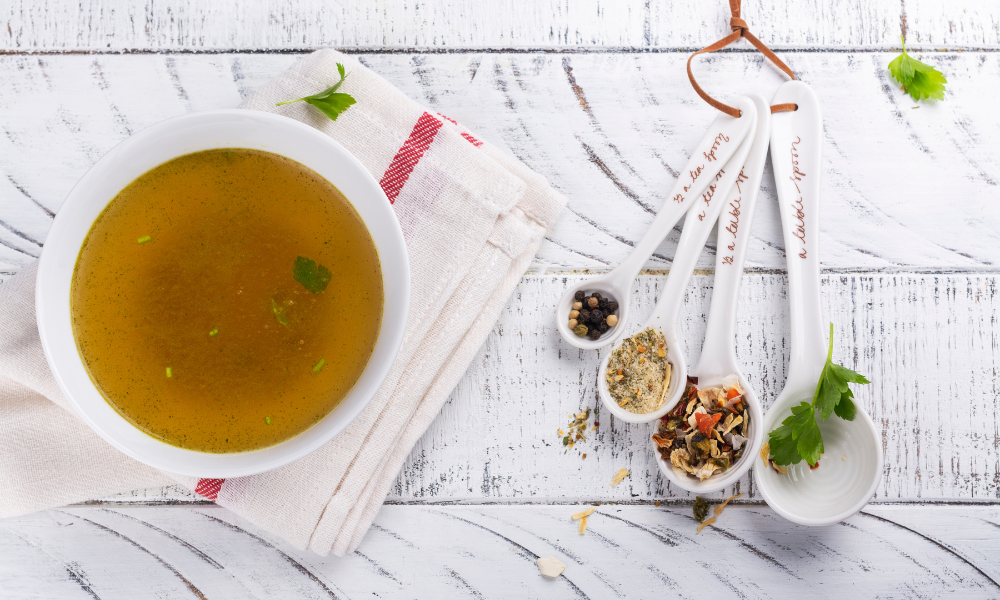Let's get to the basics of bone broth—a brew that's been in kitchens for as long as culinary history can recall. It's not just any usual broth since it's packed with nutrients and has a history that spans generations.
Just imagine bones and sometimes a bit of meat boiling in water. To amp up the goodness, we add things like vinegar or tomatoes. We might throw in veggie scraps and garlic too. Then, this mix simmers for a good while, anywhere from four to a whopping 24 hours. Why so long? Because that's when the good stuff happens. This slow cooking pulls out a bunch of nutrients, making bone broth a go-to for many. While we're still figuring out all its benefits, we know it's packed with good stuff.
What is Bone Broth?
It's as straightforward as it gets—take animal bones, add in some connective tissues, set them to simmer in a pot of water, and let the magic happen. Bone broth plays an important role in crafting those delicious soups, flavorful sauces, and comforting gravies we all love.
Here's a revelation: it's not confined to the realm of culinary delights; some prefer sipping it straight for a wholesome experience. Try it!
Delving into the past, the roots of bone broth extend to the earliest chapters of human history. All cultures use broths in their cuisines too.
Bone Broth vs Stock
Now, you may have been wondering what’s the difference between Broth and Stock. We get it, we were, from some point in time, also confused at these two. Majority of the population may have thought that they are the same, or may have interchanged their roles.
It's like comparing two siblings—similar yet distinct in their own ways. So, what sets them apart? Bone broth and stock share the same roots, both starting with a foundation of animal bones and connective tissues. The difference? It's in the details of preparation.
When crafting bone broth, these ingredients are the main point, simmering in water with the addition of acidic elements like vinegar or tomatoes. This concoction undergoes a slow dance on the stove, brewing for anywhere between four to more than 24 hours. The result? A nutrient-rich brew, boasting flavours and nutrients extracted from the bones.
Stock, on the other hand, keeps things simpler. The focus is on simmering bones with a handful of aromatic vegetables and herbs. The cooking time is shorter, typically clocking in at around four hours. The goal here is to create a flavorful liquid that serves as a base for various dishes.
So, is one better than the other? Well, that's a matter of preference. Some swear by the nutrient-packed richness of bone broth, while others appreciate the versatility of stock. The choice depends on the intended use and the flavours you crave in your culinary creations. Whether you lean towards the slow-simmered richness of bone broth or the straightforward simplicity of stock, both have a place in the kitchen, ready to elevate your dishes with their distinct characters.
Bone Broth Powder
Think of it as the "instant coffee" version of the robust, slow-simmered bone broth. This powdered marvel offers a quick fix for those craving the goodness of bone broth without the lengthy cooking time.
What makes it so appealing? Well, for starters, it's portable and shelf-stable, making it a traveller's dream and a pantry essential. With just a scoop of powder and hot water, you can summon the essence of bone broth in an instant.
But does it compromise on the nutrient front? Not necessarily. Many bone broth powders retain the nutritional profile of their liquid counterparts. The key is to choose high-quality options that prioritise real, wholesome ingredients.
So, whether you're a globetrotter seeking a sip of comfort on the go or a home cook looking to streamline your culinary creations, bone broth powder emerges as a versatile ally. It's a modern twist on a timeless tradition, bringing the nourishing benefits of bone broth to your fingertips with a simple stir.
Recommended Article: Can Powdered Bone Broth Replace Regular Broth?
Benefits of Bone Broth
After understanding the origins and forms of bone broth, let’s discuss the health benefits it holds.
Supports Joints
Ever heard the phrase "good bones"? Bone broth takes it quite literally. Packed with collagen, glucosamine, and chondroitin, it can contribute to joint health and ease the creaks and groans.
Gut Health Ally
The gut holds immense importance in our overall health, and bone broth is like a soothing balm for the digestive system. It contains amino acids like glutamine, known for nurturing the intestinal lining.
High-Quality Protein Source
Looking to up your protein intake? Bone broth has got you covered. It provides a rich source of amino acids, promoting muscle maintenance and growth.
Skin Elasticity Booster
Collagen strikes again! This time, it's offering support to your skin. Including bone broth in your diet may contribute to skin elasticity, helping you put your best face forward.
Collagen Source
Collagen isn't just for a youthful complexion; it's a structural protein found throughout the body. Bone broth provides a natural source of collagen, supporting various bodily functions.
Electrolyte Elevation
Move over, sports drinks. Bone broth, with its mineral content, can be a natural way to replenish electrolytes after a workout or a bout of dehydration.
Weight Management and Muscle Mass
Seeking a healthy, protein-rich addition to your weight management journey? Bone broth might be your go-to, fostering a sense of fullness and supporting muscle mass.
Immune System Support
The immune system could always use a helping hand, and bone broth steps in with its nutrients that may contribute to overall immune support.
As you sip on this liquid gold, remember that its benefits go beyond being just a warm and comforting drink. Bone broth, in its various forms, has the potential to become a wholesome addition to your wellness routine.
Bone Broth Nutrition
Wondering what's under the hood of your steaming cup of bone broth? Let's lift the lid and explore the nutritional richness that awaits in every savoury sip. While the exact nutrient composition can vary based on the ingredients and cooking duration, bone broth generally packs a wholesome punch.
Protein Content
Bone broth stands out as a notable source of protein. Rich in amino acids like glycine and proline, it offers a foundation for tissue repair, muscle maintenance, and overall protein needs.
Collagen Content
The collagen content in bone broth is a standout feature. As the main structural protein in connective tissues, collagen supports skin, joints, and various bodily functions.
Mineral Infusion
Minerals play a crucial role in our body's myriad functions. Bone broth serves as a mineral-rich elixir, offering a medley of essential minerals such as calcium, magnesium, phosphorus, and potassium.
Gelatin Goodness
Ever noticed that jiggly consistency of well-made bone broth when cooled? That's thanks to gelatin, derived from collagen during the cooking process. Gelatin may contribute to gut health and aid digestion.
Amino Acid Assortment
Amino acids are the building blocks of proteins, and bone broth boasts an array of them. From immune-supportive glutamine to joint-loving proline, these amino acids contribute to overall health.
Hydration Support
Staying hydrated is essential, and bone broth can be a flavorful way to contribute to your daily fluid intake. The warm broth is especially comforting during colder seasons.
Remember, the nutritional profile of your bone broth might vary based on factors like the cooking time, ingredients used, and the specific bones involved. So, as you savor your cup, relish the thought that you're treating your body to a nutrient-packed experience.
Risks of Bone Broth
Navigating the bone broth path with a caution is a must. While the benefits of bone broth are aplenty, it's essential to tread carefully and be aware of potential risks. Like any wellness trend, moderation and informed choices are key. Let's explore some considerations to keep in mind:
Lead Contamination
One potential concern with bone broth is the possibility of lead contamination. Bones, especially those from animals like chicken and fish, may contain traces of lead. This risk can be mitigated by using high-quality bones and opting for shorter cooking times.
Sodium Levels
The sodium content in bone broth can be significant, especially if salt is added during the cooking process. Individuals on restricted sodium diets should be mindful of their broth consumption or choose low-sodium alternatives.
Purine Content
Purines, naturally occurring compounds in some foods, are broken down into uric acid in the body. High intake of purine-rich foods, including bone broth, may be a consideration for those with certain health conditions like gout.
Calorie Awareness
While bone broth can be a nutritious addition to your diet, it's essential to consider your overall calorie intake. If you're aiming for weight management, be mindful of the calories in your broth and balance it with your daily dietary needs.
Not a Complete Protein Source
While bone broth contains protein, it's not a complete protein source as it may lack certain essential amino acids. If you rely heavily on bone broth for protein, ensure a varied diet to meet your amino acid requirements.
As with any dietary choice, consulting with a healthcare professional or nutritionist can provide personalised guidance based on your health status and dietary goals. While enjoying the goodness of bone broth, staying informed about potential risks ensures a well-rounded approach to your nutritional journey.
How To Incorporate Bone Broth
There are savvy ways to make broth your culinary ally. As we've explored the ins and outs of bone broth, it's time to get creative in the kitchen. Incorporating this nutritional powerhouse into your routine doesn't have to be a complex affair. That’s right!
Here are some practical and tasty ways to make bone broth a delightful addition to your culinary repertoire:
Straight Sipping
The simplest way to enjoy bone broth is by sipping it straight from a mug. Think of it as a warm, comforting beverage that nourishes from the inside out. This method allows you to savour the rich flavours without any distractions.
Soups and Stews
Elevate the taste of your favourite soups and stews by swapping out conventional broth for a hearty bone broth. Whether it's a classic chicken noodle soup or a robust beef stew, the added depth of flavour can take your dish to the next level.
Cooking Grains
Infuse your grains with the wholesome goodness of bone broth. Instead of using plain water to cook rice, quinoa, or couscous, try using bone broth. It imparts a subtle richness that complements various dishes.
Braising Meats
Upgrade your meaty dishes by incorporating bone broth into the braising liquid. The collagen-rich broth can enhance the tenderness and succulence of meats, creating a melt-in-your-mouth experience.
Sauces and Gravies
Transform ordinary sauces and gravies into culinary masterpieces with the addition of bone broth. Whether you're preparing a savoury pan sauce for meats or a luscious gravy for your Sunday roast, the depth of flavour will be unmistakable.
Smoothies and Blended Dishes
For a creative twist, consider adding bone broth to your smoothies or blended dishes. The mild flavour can effortlessly blend with fruits and vegetables, offering a nutrient-packed boost to your morning routine.
Try: Beef Bone Broth Mashed Potatoes
Freezing for Convenience
Prepare a batch of bone broth and freeze it in smaller portions. This way, you can easily grab a serving whenever needed. It's a convenient solution for busy days when you want a nourishing meal without the fuss.
Experiment with these ideas to find the bone broth incorporation method that suits your taste preferences and lifestyle. Whether you're a culinary enthusiast or a novice in the kitchen, making bone broth a part of your routine can add both nutritional value and gastronomic delight.
Nutra Nourished Beef Bone Broth

At Nutra Nourished, we believe in harnessing the wholesome benefits of nature to elevate your well-being. Our Beef Bone Broth stands as a testament to this commitment. Crafted from the bones of grass-fed and finished Australian and New Zealand beef cattle, our bone broth is a powerhouse of nutrients.
Key Features of Nutra Nourished Beef Bone Broth
Triple Collagen Boost
Our bone broth is enriched with three types of collagen — Type I, II, and III. This triple collagen boost provides comprehensive support for joint health, skin elasticity, and overall vitality.
Amino Acid Rich
Packed with amino acids, our bone broth offers a nourishing blend that supports muscle health and aids in post-exercise recovery.
Vitamins and Minerals
Nutrient-rich and brimming with vitamins and minerals, our bone broth contributes to your daily nutritional needs. It's a convenient way to ensure you're getting essential nutrients in a form that your body can readily absorb.
Grass-Fed and Finished
We source our beef bones from grass-fed and finished cattle in Australia and New Zealand. This ensures the highest quality and ethical standards in our bone broth production.
Made in Australia
Nutra Nourished's Beef Bone Broth is proudly made in Australia, adhering to strict quality control measures. This guarantees that you receive a product that meets the highest standards of purity and potency.
Incorporate Nutra Nourished's Beef Bone Broth into your daily routine to experience the nourishing benefits that nature intended. Whether you enjoy it as a comforting beverage, use it as a base for culinary creations, or savour it for its nutritional prowess, our bone broth is a versatile addition to a well-rounded, health-conscious lifestyle.




